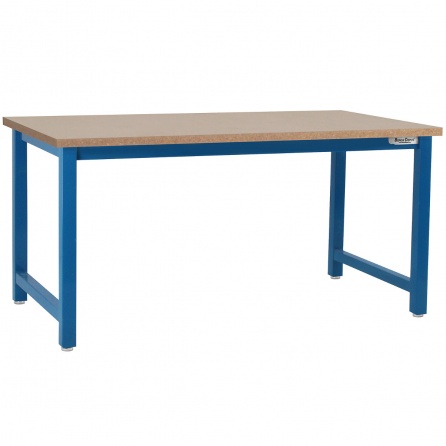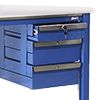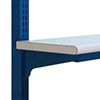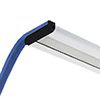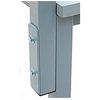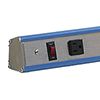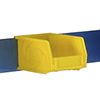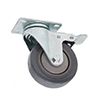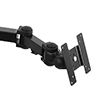Kennedy Series with Particle Board 1.1/8" Thick Top
- 6,600 Lbs. Capacity.
- One Bolt Per Leg Assembly.
- Factory Assembly Available.
- 1 1/8" Thick Particleboard.
- Glides Included.
- Steel Reinforced Top.
- 16-gauge Strong Cold Rolled Steel.
- Available 24”, 30”, 36” Deep and Custom.
! This bench design is similar in appearance to other economy brands, although our design takes about one tenth the time to assemble, we use heavier laminates, seal the bottom, powder paint our frames, our warranty is much longer, and our weight capacity is higher.
Workbench WarrantyBenchPro™ has been producing the nation's strongest, longest lasting ergonomic workbenches since 1987. We are so sure our products will perform properly, we offer the following warranty: BenchPro™ benches, options and accessories are warranted to the original purchaser for 25 - years. This includes every component and every function. Exceptions: Eisenhower series are warranted for ten years. Workbenches used in multiple shift operations shall have the warranty prorated accordingly. Hydraulic bench lift - system components are warranted for ten - years. All lighting products are warranted for ten - years. BenchPro™ will either refund the entire purchase price including freight and tax (if any) or replace the product or component that is defective, and pay for the freight. Product Returns: As we make all products from base materials, we charge a "restocking charge" on products returned if for no fault of ours. We also charge a restocking charge for products ordered but cancelled after the product is built. We do not accept used product back. If returned product is due to our fault, we credit the full cost, and freight. Restocking charge schedule: A. All Workbenches and Accessories in standard sizes and colors will be charged 25%. No return of defective product is ever required. (We may ask for an electronic photo in cases where we have not seen the problem before). From the lawyers: In no case shall BenchPro™, its distributors, employees, related divisions, and other entities be responsible for any direct, consequential or indirect damage caused by the use, inability to use, or incorrect use of our products. Our liability shall be limited to replacement of product or a full refund. Due Diligence: Please, if a chair or workbench is found to be defective in a way that could lead to an accident, take it out of service and tag it as dangerous until replacements or replacement parts are received and assembled. Dangerous products should not be put into open waste disposal systems until they have been made unusable, so that no third party can reclaim them and be injured.
|
||
| Test | Basis | Description | Pass | Media |
Horizontal Static Load Test. BSI EN 13150:2001 A.3.1 |
Evaluate the ability of the workbench to withstand fatigue stress and wear caused by horizontal forces on the workbench top. | 72.5 Psi is applied ten times at the center of each edge. The feet are securely attached to the floor and a verified distance of inflection is observed. To pass the test, the components of the bench are inspected and verified to have full integrity and no reduction in functionality. |
||
Vertical Static Load Test. BSI EN 13150:2001 A.3.2 |
Evaluate the ability of the workbench to withstand fatigue stresses caused by a vertical impact. |
105 PSI is applied with a downward force 10 times on each edge. Following the test, the bench is inspected for warping or damage. No changes were found. |
||
Sustained Vertical Load Test. BSI EN 13150:2001 A 3.3 |
Evaluate the ability of the workbench to withstand a load for 24 hours. |
1.25 kg / sqm (275 lbs / sqin) is uniformly loaded into the surface of the workbench. 24 hours pass. Eight points are measured to ground before loading, after loading and once the load is removed to determine if there is any inflection of the workbench. The bench is inspected for damage following the test as well. The Kennedy Series is rated to hold up to 5,500 lbs on the surface. This weight had no impact on performance of the bench. |
||
Horizontal Impact Stability Test of Free Standing Workbenches. BSI EN 13150:2001 A 3.5 |
Verify the ability of a workbench to withstand a repeated impact from people walking into it. |
A basketball that is filled to 72.5 psi is attached to a weight and dropped from a standard distance to simulate the impact of a person walking into the table with 110 psi. The impact is repeated and the table is inspected for damage. No damage occurred. |
||
Drop Test of movable workbenches (tables). BSI EN 13150:2001 A 3.7 |
The purpose of this test is to check the strength and functionality of the casters after being tested in free fall strike the floor. |
The workbench is dropped from a height of approximately 6" ten times on each end. The casters are tested in the locked position. Following the test, it was verified that the bench maintained full and smooth motion of the wheels. | ||
Horizontal Fatigue Test. BSI EN 13150:2001 B.3 |
Verify the ability of the workbench to withstand multiple side impacts. | 72.5 PSI are applied 30,000 times to each end while 110 lb. weighs the top of the table down. Following the test, the bench is inspected for damage and none was found. |
||
Vertical Fatigue Test. BSI EN 13150:2001 B.4 |
Evaluate the ability of the workbenches to withstand fatigue stresses and wear caused by vertical forces on the workbench top. | 110 PSI is applied at the middle of the long edge in a downward direction. This is repeated 20,000 times on each edge. Following the test, the bench is inspected for signs of fatigue. No fatigue occurred. | ||
Vertical Impact Test. BSI EN 13150:2001 B.5 |
The purpose of this test is to check the strength and functionality of the workbench. | 55 lb is dropped onto the middle of each edge from 6 in, 8 in and one foot. Following the test, the bench is inspected for structural damage. The bench was not affected. | ||
| BenchPro™ Pull Test | Verfies the ability of the workbench frame to endure a large force from the side. | The bench is secured to the ground and the top is pulled laterally at 450 psi until the bench has shifted 1 inch toward the force. Following this, the bench is inspected for damage and none was found. |
The unique characteristics of LisStat™ Static Dissipative Laminate make it ideally suited for a variety of sensitive electronic production applications.
LisStat™ Static Dissipative Laminate Sheets are designed for permanent lamination to work station surfaces.
LisStat™ meets and surpasses all standards for electrical dissipation as they apply to static control, even at low humidity levels. These standards include ANSI/BIFMA, ESDI, GSA and many others.
LisStat™ Static Dissipative Laminate Sheets are designed for permanent lamination to work station surfaces.
All BenchPro™ ESD benches are only available with ergonomic contoured front edges. This way, the ESD laminate conducts the static charges all the way to the steel frame. The steel frame has two wrist strap jacks mounted on the top of the two front legs for convenience. BenchPro™ also provides one grounding wire to take the static from the frame to either an adjoining bench or to ground.
To guarantee a static clear work area, all BenchPro™ ESD bench top have their edges laminated with the same static control laminates as used on the top, while the underside of the tops have a laminated solid aluminum sheet.
Kennedy Series Bench Assembly.
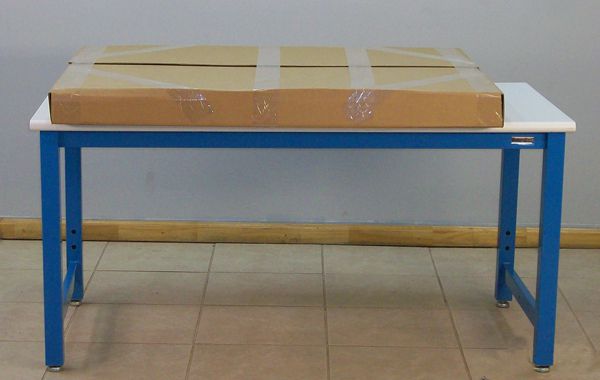
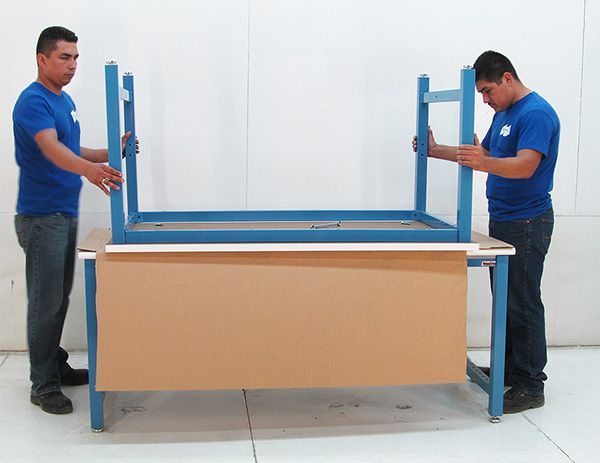


5. If you ordered drawers or CPU holder, assemble them next. (See instructions below)
6. Turn it over. You're done!
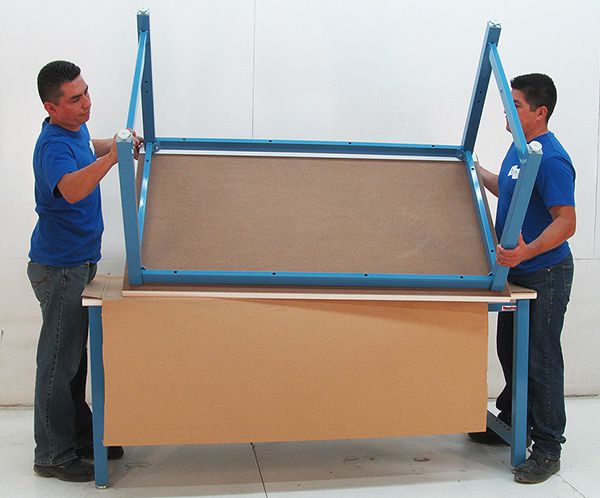
What is the best work surface height for me?
You can order your benches at any work surface height without incurring additional cost, or select the lowest height you believe useful and add either our optional adjustable legs, our electric lift system or our crank-up system.
We have seen orders for almost every work surface height. Some Customers want to sit down and work, others want to stand. Here are some thoughts that may be of assistance:
1. Desks are 30" high.
2. Desk chairs usually have a seat cushion height adjustability range of around 17" to 22".
3. Work surfaces should never be more than 9" higher than the top of the chair range. Conclusion: If you need a work surface higher than 31", you will need a taller chair.
4. Taller chairs usually have a foot ring and a wider base. (Adjustable foot rings are critical as employees come in all sizes too.)
5. Our taller chairs have a seat cushion height adjustability range of 22" to 32". (Some brands have ranges of only 5" or 8".)
6. We do not recommend chairs be used at benches with work surfaces of 37" and higher, as some employees will attempt to "climb" the chair, and could be injured when the chair rolls or tips.

